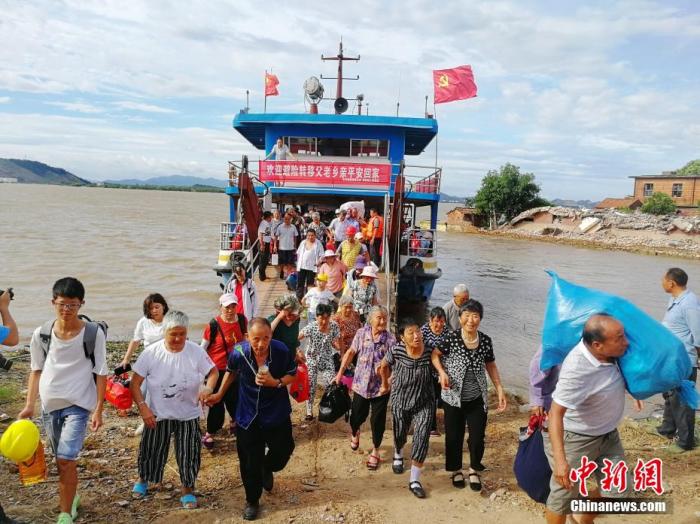China News Service, August 9th. According to the official WeChat news of the Emergency Management Department, on the 9th, the Emergency Management Department dispatched 2 disaster relief working groups to Anhui and Jiangxi, and then sent 2 disaster relief working groups to Hubei and Hunan. Organize and carry out disaster inspection and evaluation, guide and urge local governments to do a good job in helping people affected by disasters, promote the restoration and reconstruction of damaged houses, and prevent poverty and return to poverty due to disasters.
As the water level of the Yangtze River dropped, starting on August 6, Pengze County, Jiangxi Province officially launched the resettlement plan for people returning to their hometowns. The picture shows the people returning home. Photo by Han Kaiqiang
It is predicted that from August 11th to 13th, there will be a heavy rainfall process in the eastern part of Northwest China, North China, Northeast China, Huanghuai and Sichuan Basin. There will be heavy to heavy rain in some areas, and there will be heavy heavy rain in the above areas. There are strong convective weather such as short-term heavy precipitation, thunderstorms, gales or hail. The National Defense Office and the Ministry of Emergency Management held a meeting on the 9th to discuss the development trend of rain and flood with the Ministry of Water Resources, the Ministry of Natural Resources, and the China Meteorological Administration, and arrange for a new round of heavy rainfall prevention and response work in key areas.
The meeting requested that the prevention and control authorities at all levels should closely monitor the hidden dangers caused by the new round of heavy rainfall, continue to maintain a high level of vigilance, further strengthen ideological understanding and responsibility implementation, strengthen monitoring and early warning and hidden danger investigation, and comprehensively investigate reservoirs, tailings reservoirs, and mountain torrents. Key regional risk hazards such as hidden danger points of geological disasters and urban waterlogging prone areas, etc., should pay close attention to various measures for flood prevention and disaster relief. It is necessary to strictly implement rolling consultations, strengthen inspections and defenses in key areas such as embankments in super-alarm sections, mountain torrents and geological hazards, and timely discover hidden dangers and quickly organize emergency treatment. It is necessary to strengthen personnel transfer and avoidance, implement detailed personnel avoidance transfer plans, strengthen material supplementation and emergency force deployment, and effectively put the safety of people's lives in the first place.
On the 9th, the National Defense Office issued a notice to all provinces, autonomous regions, and municipalities, and the Xinjiang Production and Construction Corps. It required the prevention and control of all levels to do a new round of heavy rainfall prevention and information submission, and further strengthened detailed flood prevention and emergency rescue. Implement the disaster relief responsibility system, strengthen supervision and inspection and supervision, release early warning information in a timely manner, strengthen the investigation and rectification of hidden dangers, make emergency rescue teams and materials preparations, put early risk avoidance in the most prominent position, and transfer personnel must be determined and determined. The transfer should be transferred as soon as possible to effectively protect the lives of the people. Strengthen information reporting, and report relevant information to the National Defense Office in a timely manner in accordance with the provincial list of items to be reported for prevention and control and the provisions on emergency disaster reporting.
On August 9, the Ministry of Emergency Management, based on sending two disaster relief working groups to Anhui and Jiangxi, sent two more disaster relief working groups to Hubei and Hunan to organize disaster inspection and evaluation, and guide and urge local governments to provide relief to the victims. Support work, promote the restoration and reconstruction of damaged houses, and prevent poverty and return to poverty due to disasters. The Anhui and Jiangxi working groups have gone to the hardest-hit areas such as Huangshan, Anqing, Jiujiang, and Shangrao for the past few days to conduct disaster inspections and assessments, check and understand the management and use of disaster relief funds, post-disaster recovery and reconstruction, etc., and guide and supervise the local areas to do a good job in relief and assistance work for the victims. Guarantee the basic livelihood of the masses.
The Emergency Management Department guides and urges key provinces such as Anhui, Jiangxi, Hubei, and Hunan to do a good job in the safety management of centralized resettlement sites and the relief work of the people. At present, there are 339 centralized resettlement sites in the above-mentioned provinces, accommodating nearly 25,000 people affected by the disaster, a decrease of 23,000 from a week ago. Under the premise of ensuring safety, the local party committee and government of the disaster-stricken areas are organizing the victims to return home in an orderly manner to help recover as soon as possible. Normal production and living order, reconstruction of homes.

